|
By accessing/using The Crittenden Automotive Library/CarsAndRacingStuff.com, you signify your agreement with the Terms of Use on our Legal Information page. Our Privacy Policy is also available there. |

Pontiac History on Native American Heritage Day
|
|---|
|
|
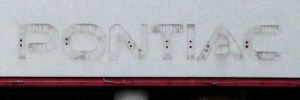 Opinions expressed by Bill Crittenden are not official policies or positions of The Crittenden Automotive Library. You can read more about the Library's goals, mission, policies, and operations on the About Us page.
Opinions expressed by Bill Crittenden are not official policies or positions of The Crittenden Automotive Library. You can read more about the Library's goals, mission, policies, and operations on the About Us page.
|
Pontiac History on Native American Heritage Day
Bill Crittenden
November 28, 2014
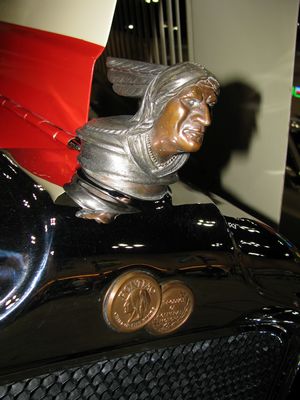 Hood ornament and emblem (the text in the left circle reads "Chief of the Sixes") from a 1928 Pontiac Landau. The bronze hood ornament seems hopelessly gaudy today but was de rigeur for the era.
Film showing the 1935 marketing plan to Pontiac dealers. Hood ornament and emblem (the text in the left circle reads "Chief of the Sixes") from a 1928 Pontiac Landau. The bronze hood ornament seems hopelessly gaudy today but was de rigeur for the era.
Film showing the 1935 marketing plan to Pontiac dealers.
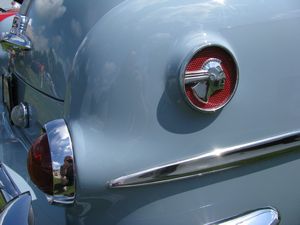 The "Indian Head" logo of a 1951 Chieftain Deluxe. The "Indian Head" logo of a 1951 Chieftain Deluxe.
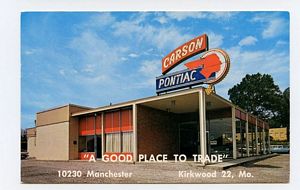 A postcard from Carson Pontiac. A postcard from Carson Pontiac.
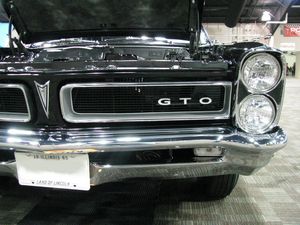 The chrome arrowhead popular on Pontiac cars of the 1960's, this one on a 1965 GTO. The chrome arrowhead popular on Pontiac cars of the 1960's, this one on a 1965 GTO.
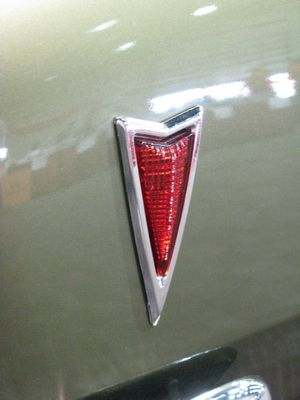 One of my favorite styling touches of all time, the arrowhead turn signal lens on a 1968 Firebird. One of my favorite styling touches of all time, the arrowhead turn signal lens on a 1968 Firebird.
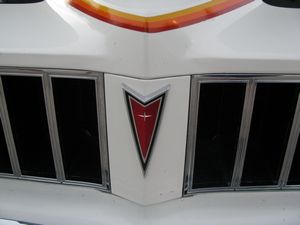 The modern red enamel arrowhead leads the way on the front of a 1977 Le Mans Can Am. The modern red enamel arrowhead leads the way on the front of a 1977 Le Mans Can Am.
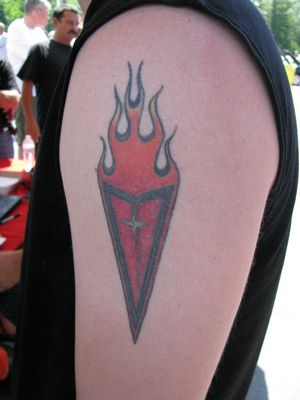 Few brands have inspired as much dedication and love as Pontiac. Few brands have inspired as much dedication and love as Pontiac.
|
Today is Native American Heritage Day. For better or for worse, there's one Native American name that has become a household name across the country.
That name we all know is Pontiac. The man was Chief Pontiac of the Ottawas, who lived from about 1720 to 1769.
The story of Chief Pontiac is older than the United States of America, but the connection to the automobile wouldn't...couldn't...get started for over century and a quarter after his death.
Well, there was a bridge between the colonial and automobile eras in the 1800's, when a small village was settled in 1818 and incorporated in 1861, taking the name of the Chief who had rebelled against the British in nearby Detroit a dozen years before the rest of the colonies would.
Pontiac, Michigan would become the county seat of Oakland County, close enough to Detroit to be a part of the city's great automobile industry boom.
A car company founded in Oakland County in 1907 would take the Oakland name and be absorbed into General Motors in 1909. When Oakland was a GM brand, it was slotted in between Chevrolet at the bottom and Oldsmobile above.
In 1926, GM created a "companion brand" to Oakland and called it Pontiac. Inspiration for the name came from the county seat of Oakland County, but as the town of Pontiac was in turn named for Chief Pontiac, General Motors began using Native American imagery in the marketing of the vehicle. No actual images of Chief Pontiac are known to exist, so artistic license was taken in creating a generic Native American whose appearance would change a bit from decade to decade.
Pontiac outsold Oakland and when the companion brand program was ended (each GM brand had a "companion"), Pontiac had replaced Oakland, which was phased out, making Pontiac the only companion brand to survive the 1920's.
It did more than survive. It thrived. Taking Oakland's place between Chevrolet and Oldsmobile, the brand went on to become an American automotive legend.
GM had used an "Indian Head" emblem in various forms from the beginning of the brand until 1956. Model names often went along with the theme and included Star Chief and Chieftain.
For the 1957 model year, the brand changed styles completely, making the connection to Native American imagery as subtle as possible. The logo became a downward-pointing arrowhead that drivers of most younger generations associate with the brand. Native American model names were phased out in favor of racing themed names such as Bonneville, Grand Prix, and the almost universally recognized Pontiac GTO, America's first "muscle car." Marketing focused on racing, power, and speed as it became the performance brand of GM.
Despite the official change, dealership salesmen and Pontiac drivers still made references to the Native American theme, most notably the "Tin Indian" drag car of the late 60's.
Not to defend the practice, but just for context you have to remember that Pontiac existed as a brand at a point in America's cultural history when westerns were popular and kids played "cowboys & Indians." General Motors was actually far, FAR ahead of the curve phasing out the imagery considering that the Cleveland Indians baseball team didn't retire the offensive caricature called "Chief Wahoo" until just a few years ago.
Because of the artistic license taken on the emblem (and, I believe, the downward point of a symbol usually seen pointed sideways), many younger drivers I've talked to don't seem to be aware that it's even an arrowhead or the history that the emblem is connected to. People of my generation grew up in the "Pontiac Excitement" marketing era of the company, where high-tech style and performance were the cornerstones of the brand's image, the abstract logo was just one in an auto industry full of abstract logos with little or no discernible meaning, and the popular model names were the Firebird, Fiero, Grand Am, Bonneville, and Trans Am.
Despite having excellent brand-exclusive products not sold by other American GM marques, including the Solstice and the G8, Pontiac was phased out in 2010 in a government-led reorganization of General Motors. Aside from the consolidation of GM, which was seen by its government minders as having too many brands, no official reason was given as to why specifically Pontiac was chosen to be closed down.
Personally, as a fan of Pontiac, I feel Buick should have been the one to go, but that's just me...and every other Pontiac fan I've talked to.
While sad for us fans of the cars, the company bowed out before a renewed awareness of cultural appropriation that has seen harsh criticism of sports teams, including most notably the aforementioned Cleveland Indians and the too-offensive-to-name Washington NFL team. This, perhaps, allowed Pontiac a "clean," uncontroversial exit from the business, in a way putting some of GM's old skeletons back
in the closet before BuzzFeed could dig up a fun bundle of embarrassing imagery from Pontiac's past and make it an issue today.
The modern symbol was, despite the vagueness, inspired by a weapon,
yet another reference to Native Americans and warfare that's seen in the "tomahawk chop" of the Atlanta Braves and every team that uses a Native American logo for a team named "Warriors."
Perhaps insensitivity wasn't entirely buried in 1957. Maybe that's why Pontiac had to go instead of Buick. Maybe the logo had nothing to do with it, and GM is just lucky it dodged another controversy.
While the marketing is a relic of the past, we still have the cars. And what great cars so many of them are! The epic split-fin 1959 Bonneville, the "original muscle car" 1964 GTO, the iconic orange GTO Judge, 1967 Firebird, the Trans Am from Smokey and the Bandit (complete with "flaming chicken" decal), race winners and champions in multiple eras of racing including NASCAR's closest ever finish being won by a Pontiac nose, the potential and the disappointment of the still-loved Fiero, and my personal favorite: the best car I've ever owned...a 2003 Vibe AWD.
Judgment on the use of the name and the logos aside, a Native American chief's name has wound it's way through history to become one of the most iconic in the story of America's automobile industry, and has been spread far and wide beyond the hills of the Detroit suburbs to every highway and millions of garages across the country, as well as film and television screens around the world with appearances in hundreds of Hollywood productions.
Now, today being a good day for it, the car guys of America owe Chief Pontiac at least a few minutes of our time to learn more about who the man was behind the name and why he was famous enough to name a town and an automobile marque after. You can
read about his personal life or
the rebellion that bears his name, a rebellion that even has a connection to the American Revolutionary War about a dozen years afterward.

















 Opinions expressed by Bill Crittenden are not official policies or positions of The Crittenden Automotive Library. You can read more about the Library's goals, mission, policies, and operations on the About Us page.
Opinions expressed by Bill Crittenden are not official policies or positions of The Crittenden Automotive Library. You can read more about the Library's goals, mission, policies, and operations on the About Us page.
